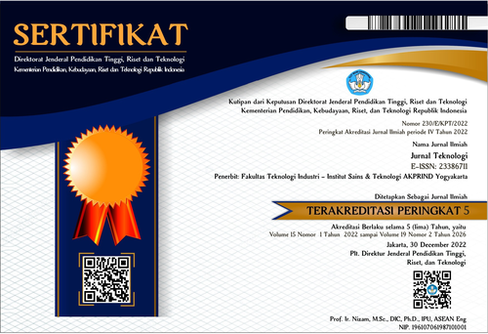WLAN FINGERPRINT UNTUK PREDIKSI LOKASI OBJEK DALAM GEDUNG
Keywords:
RSS, k-NN, Naïve Bayes, FingerprintAbstract
Kemajuan teknologi Wireles LAN sudah sangat banyak digunakan publik sebagai media komunikasi dan banyak diaplikasikan di berbagai tempat, mulai dari kampus, pertokoan, perkantoran bahkan tempat-tempat umum. Teknologi wireless LAN dengan memanfaatkan nilai RSS (Received Signal Strength) yang diperoleh dari acces point (AP) yang sudah ada bisa di aplikasikan untuk estimasi lokasi objek dalam ruangan . latar belakang Hal ini yang mendasari untuk estimasi lokasi objek dalam ruangan dengan metode fingerprint.
Penelitian ini difokuskan pada pemanfaatan RSS mengunakan 5 acces point dan lokasi penelitian dilakukan di lantai 3 gedung JTETI UGM. Pengambilan data fingerprint dilakukan dengan grid 1 x 1 meter bertujuan untuk mendapatkan tingkat akurasi yang tinggi. Memprediksi lokasi objek ini dengan metode fingerprint mengunakan algoritma k-Nearest Neighbor (kNN) dan Naïve Bayes.
Dari fase off-line hasil Visualisasi pada peta fingerprint menunjukan bahwa kekuatan sinyal yang diterima disetiap grid pengukuran berbeda. fase on-line rata-rata kesalahan jarak terhadap estimasi lokasi algoritma Naïve Bayes lebih baik dibanding dari algoritma kNN.
Downloads
References
Bshara. Mussa, G. Fredrik, V.B. Leo, Fingerprinting Localization in Wireless Networks Based on Received-Signal-Strength Measurements: A Case Study on WiMAX Networks, in: IEEE Transactions on Vehicular Technology, Vol 59 No. 1, Jan. 2010.
Ethem, A., 2010, Introduction Machine Learning second edition, Handbook, The MIT Press, Cambridge Massachusetts, London
Fang, S. H., et al, 2008, A novel algorithm for multipath Fingerprinting in indoor WLAN environment, IEEE Transactions On Wireless Communications, Vol. 7, No. 9, pp. 3579-3588
Garcia, M., et al, 2007, Wireless Sensors self-location in an Indoor WLAN environment, International Conference on Sensor Technologies and Applications, 0-7695-2988-7/07 IEEE
Hui, L., et al, 2007, Survey of Wireless Indoor Positioning Techniques and Systems, IEEE Transactions On Systems, Man, And Cybernetics—Part C: Applications And Reviews, Vol. 37, No. 6
Salim Outemzabet, Chahe Nerguizian “Accuracy Enhancement of an Indoor ANN-based Fingerprinting Location System Using
Jorge J. Robles, Martin Deicke and Ralf Lehnert ”3D fingerprint-based Localization for Wireless Sensor Networks” in Proceedings of the IEEE , 2010.Kalman Filtering" 978-1-4244-2644-7/ 08 /IEEE, 2008
Junyang. Z., et al, 2008, Enhancing Indoor Positioning Accuracy By Utilizing Signals From Both The Mobile Phone Network And The Wireless Local Area Network, 22nd International Conference on Advanced Information Networking and Applications, IEEE
Kaemarungsi, K., 2005, Design Of Indoor Positioning Systems, Based On Location Fingerprinting Technique, Disertasi
Liu, H. Darabi,P. Banerjee, J. Liu, “Survey of Wireless Indoor Positioning Techniques and Systems” in IEEE Transactions on System, Man and Cybernetics Vol, 37, No, 6, Nov. 2007.
Widyawan, 2009, Learning Data Fusion for Indoor Localisation, Master Thesis, Department of Electronic Engineering Cork Institute of Technology
Wilson, M. Y., et al, 2007, Wireless Lan Positioning Based On Received Signal Strength From Mobile Device And Access Points, 13th IEEE International Conference on Embedded and Real-Time Computing Systems and Applications (RTCSA 2007),
Downloads
Published
How to Cite
Issue
Section
License
Jurnal Teknologi provides immediate open access to its content in order of making research freely available to the public to support a global exchange of knowledge. All articles published in this journal are free for everyone to read and download, under licence CC BY SA.
Benefits of open access for the author, include:
- Free access for all users worldwide.
- Authors retain copyright to their work.
- Increased visibility and readership.
- No spatial constraints.




















